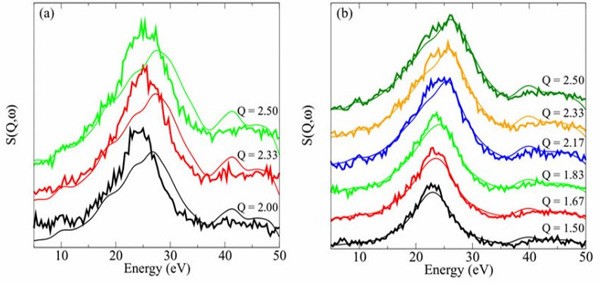HIGH-ENERGY PLASMONIC EXCITATIONS IN 2D TRANSITION-METAL DICHALCOGENIDES*
Transition-metal dichalcogenides (TMDC) have attracted a tremendous interest in the last years as they exhibit many interesting properties, such as the coexistence of two competing electronic orders: superconductivity and charge-density wave (CDW) as well as of optical valley control and valleytronics in MoS2 monolayers.

In particular, an intense debate has developed around the origin of CDW order and its impact on the spectroscopic properties of these materials. A key quantity to disentangle both CDW and superconductivity orders is the dynamic density response, quantified by the loss function, or equivalently the dynamic structure factor S(q,ω). Its investigation has been the subject of a very recent EELS study which has reported a negative plasmon dispersion for in-plane momentum transfers of the loss function of 2H-NbSe2 [1]. This result is in contrast with the expectations deriving from the homogeneous electron gas, where the plasmon dispersion is positive. The negative plasmon dispersion was ascribed to correlation effects arising from the incipient CDW order [1].
In an earlier publication [2] we presented the results of an extensive ab initio theoretical analysis of the loss functions of two prototypical TMDC materials, namely 2H-NbSe2 and 2H-Cu0.2NbS2, which respectively does and does not exhibit a CDW ordered phase. We found a negative plasmon dispersion in both materials and proposed a very general and simple interpretation of the in-plane negative plasmon behavior. Our interpretation links the peculiar anisotropic band structure of those systems with narrow d-symmetry bands crossing the Fermi level.
Our study was conducted at ID20 using nonresonant inelastic x-ray scattering (IXS) spectroscopy. The results represent an important step towards the understanding of neutral excitations in this class of materials. In fact, at variance of the previous theoretical and experimental works that mainly focused on the low energy plasmon, we investigated the dynamic density response at higher energy up to 50 eV for momentum transfer normal to the plane of the layers. The dynamic range in energy and momentum required by this study is only accessible to IXS. Our results are summarized in Fig. 1 where we compare the measured loss function obtained by IXS with state-of-the-art time dependent density functional theory (TDDFT) calculations performed in adiabatic local density approximation (ALDA). The agreement between theory and experiment is good enough to show that TDDFT-ALDA is able to capture the physics of the collective excitations in this class of materials. At the same time we found that the spectra of 2H-NbSe2 and 2H-Cu0.2NbS2are similar not only at low energy and for in plane momentum transfer as shown in Ref. [2] but also at higher energy and large momentum transfer normal to the plane. This result further validates our interpretation of the in-plane negative dispersion of the low energy plasmon reported in the previous work.
References:
- [1] J. van Wezel et al., Phys. Rev. Lett. 107, 176404 (2011).
- [2] P. Cudazzo, M. Gatti, A. Rubio, Phys. Rev. B 86, 075121(2012).



